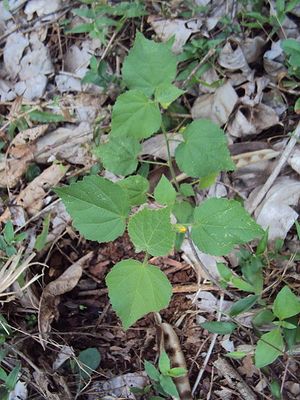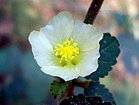Note: This is a project under development. The articles on this wiki are just being initiated and broadly incomplete. You can Help creating new pages.
Difference between revisions of "Sida cordifolia - Bala"
(→Flower) |
(→List of Ayurvedic medicine in which the herb is used) |
||
| (16 intermediate revisions by 2 users not shown) | |||
| Line 1: | Line 1: | ||
| − | |||
| − | |||
[[File:450px-Sida cordifolia 01.JPG|thumb|right|''Bala'', ''Sida cordifolia'']] | [[File:450px-Sida cordifolia 01.JPG|thumb|right|''Bala'', ''Sida cordifolia'']] | ||
| − | ''' | + | '''Sida cordifolia''' is a perennial shrub of the mallow family Malvaceae and it is native to India. its seeds and root are used to make medicine. |
| − | |||
| − | |||
==Uses== | ==Uses== | ||
| Line 11: | Line 7: | ||
==Parts Used== | ==Parts Used== | ||
| − | {{Parts Used| | + | {{Parts Used|Roots}}, {{Parts Used|seed}}, {{Parts Used|Leaves}}. |
==Chemical Composition== | ==Chemical Composition== | ||
| Line 17: | Line 13: | ||
==Common names== | ==Common names== | ||
| − | {{Common names|kn=Hethutti, Bili kurunthotti|ml=Vellooram, Velluram|sa=Bala, Batyalaka|ta=Mayir-manikham|te= | + | {{Common names|kn=Hethutti, Bili kurunthotti|ml=Vellooram, Velluram|sa=Bala, Batyalaka|ta=Mayir-manikham|te=Chirubenda|hi=Bariar, Kungyi Khareti, Kharenti|en=Country mallow}} |
| + | |||
| + | ==Properties== | ||
| + | Reference: Dravya - Substance, Rasa - Taste, Guna - Qualities, Veerya - Potency, Vipaka - Post-digesion effect, Karma - Pharmacological activity, Prabhava - Therepeutics. | ||
| + | ===Dravya=== | ||
| + | |||
| + | ===Rasa=== | ||
| + | |||
| + | ===Guna=== | ||
| + | |||
| + | ===Veerya=== | ||
| + | |||
| + | ===Vipaka=== | ||
| + | |||
| + | ===Karma=== | ||
| + | |||
| + | ===Prabhava=== | ||
==Habit== | ==Habit== | ||
| Line 30: | Line 42: | ||
===Fruit=== | ===Fruit=== | ||
| − | {{Fruit| | + | {{Fruit|Loculicidal capsule|7.5–11 cm long, 1.5 cm broad|fruits are with 8 – 10 strongly reticulated mericarps, ciliate on the upper margins and fruiting from October to January.|12-20 seeds}} |
===Other features=== | ===Other features=== | ||
==List of Ayurvedic medicine in which the herb is used== | ==List of Ayurvedic medicine in which the herb is used== | ||
| − | * [[ | + | * [[Bala taila]] |
| + | * [[Balarishta]] | ||
| + | * [[Ksheerabala 101 taila]] | ||
| + | <ref name="Ayurvedic preparations"/> | ||
==Where to get the saplings== | ==Where to get the saplings== | ||
| Line 46: | Line 61: | ||
==Commonly seen growing in areas== | ==Commonly seen growing in areas== | ||
| − | {{Commonly seen|Tropical}}, {{Commonly seen|Subtropical | + | {{Commonly seen|Tropical area}}, {{Commonly seen|Subtropical area}}, {{Commonly seen|Sandy soil area}}. |
==Photo Gallery== | ==Photo Gallery== | ||
<gallery class="left" caption="" widths="140px" heights="140px"> | <gallery class="left" caption="" widths="140px" heights="140px"> | ||
| − | + | (Sida cordifolia) at Kambalakonda Wildlife Sanctuary 02.JPG | |
| − | + | (Sida cordifolia) at Kambalakonda Wildlife Sanctuary 04.JPG | |
| − | + | Country Mallow (Sida cordifolia) (17389129342).jpg | |
| − | + | Sida cordifolia (Bala) in Hyderabad, AP W IMG 9420.jpg | |
| + | Sida cordifolia (Bala) in Hyderabad, AP W IMG 9422.jpg | ||
</gallery> | </gallery> | ||
| Line 59: | Line 75: | ||
<references> | <references> | ||
| − | <ref name="Leaf">[http://eol.org/pages/703261/details " | + | <ref name="Leaf">[http://eol.org/pages/703261/details "Morphology"]</ref> |
| − | <ref name="How to plant/cultivate">[http://tropical.theferns.info/viewtropical.php?id=Sida+cordifolia " | + | <ref name="How to plant/cultivate">[http://tropical.theferns.info/viewtropical.php?id=Sida+cordifolia "Cultivation Details"]</ref> |
| − | <ref name="Uses">[https://www.bimbima.com/ayurveda/herb-information-balasida-cordifolia/614/ " | + | <ref name="Uses">[https://www.bimbima.com/ayurveda/herb-information-balasida-cordifolia/614/ " Medicinal Use and Health Benefits"]</ref> |
</references> | </references> | ||
==External Links== | ==External Links== | ||
| + | * [http://www.planetayurveda.com/library/bala-sida-cordifolia Sida cordifolia on planet ayurveda] | ||
| + | * [https://www.bimbima.com/ayurveda/herb-information-balasida-cordifolia/614/ Bala (Sida Cordifolia) Medicinal Use and Health Benefits] | ||
| + | * [https://easyayurveda.com/2012/10/03/country-mallow-sida-cordifolia-ayurveda-details-health-benefits/ Sida cordifolia-uses, side effects] | ||
| + | * [https://www.medindia.net/alternativemedicine/bala.asp Sida cordifolia on medindia,net] | ||
[[Category:Herbs]] | [[Category:Herbs]] | ||
| + | [[Category:Ayurvedic herbs that don't have seed photos]] | ||
| + | [[Category:Malvaceae]] | ||
Latest revision as of 12:05, 13 June 2019
Sida cordifolia is a perennial shrub of the mallow family Malvaceae and it is native to India. its seeds and root are used to make medicine.
Contents
- 1 Uses
- 2 Parts Used
- 3 Chemical Composition
- 4 Common names
- 5 Properties
- 6 Habit
- 7 Identification
- 8 List of Ayurvedic medicine in which the herb is used
- 9 Where to get the saplings
- 10 Mode of Propagation
- 11 How to plant/cultivate
- 12 Commonly seen growing in areas
- 13 Photo Gallery
- 14 References
- 15 External Links
Uses
Bleeding piles, Diarrhea, Fever, Gonorrhea, Aphrodisiac, wounds, Ophthalmia, Painful urination, Paralysis, headache, loss of voice[1]
Parts Used
Chemical Composition
The following alkaloids were reported from S. cordifolia growing in India and β-phenethylamine, ephedrine, pseudo-ephedrine, S-(+)-Nb-methyltryptophan methyl ester, hypaphorine, vasicinone, vasicinol, choline, and betaine.
Common names
| Language | Common name |
|---|---|
| Kannada | Hethutti, Bili kurunthotti |
| Hindi | Bariar, Kungyi Khareti, Kharenti |
| Malayalam | Vellooram, Velluram |
| Tamil | Mayir-manikham |
| Telugu | Chirubenda |
| Marathi | NA |
| Gujarathi | NA |
| Punjabi | NA |
| Kashmiri | NA |
| Sanskrit | Bala, Batyalaka |
| English | Country mallow |
Properties
Reference: Dravya - Substance, Rasa - Taste, Guna - Qualities, Veerya - Potency, Vipaka - Post-digesion effect, Karma - Pharmacological activity, Prabhava - Therepeutics.
Dravya
Rasa
Guna
Veerya
Vipaka
Karma
Prabhava
Habit
Identification
Leaf
| Kind | Shape | Feature |
|---|---|---|
| serrate | Heart shaped | The leaves are truncate, 2.5-7 cm long and 2.5-5 cm broad, with 7-9 veins |
.[2]
Flower
| Type | Size | Color and composition | Stamen | More information |
|---|---|---|---|---|
| Small | 2.5 cm long | yellow or white in colour | Petals 5 | solitary and axillaries; Calyx campanulate; lobes 5, triangular, densely pubescent outside. Petals 5, pale yellow. Stamens monadelphous and Plant flowers from August to December |
Fruit
| Type | Size | Mass | Appearance | Seeds | More information |
|---|---|---|---|---|---|
| Loculicidal capsule | 7.5–11 cm long, 1.5 cm broad | fruits are with 8 – 10 strongly reticulated mericarps, ciliate on the upper margins and fruiting from October to January. | 12-20 seeds | {{{5}}} | {{{6}}} |
Other features
List of Ayurvedic medicine in which the herb is used
Where to get the saplings
Mode of Propagation
How to plant/cultivate
Prefers a lighter, sandy soil in a sunny position[4]
Commonly seen growing in areas
Tropical area, Subtropical area, Sandy soil area.
Photo Gallery
References
- ↑ " Medicinal Use and Health Benefits"
- ↑ "Morphology"
- ↑ Cite error: Invalid
<ref>tag; no text was provided for refs namedAyurvedic preparations - ↑ "Cultivation Details"
External Links
- Pages with reference errors
- Ayurvedic Herbs known to be helpful to treat Bleeding piles
- Ayurvedic Herbs known to be helpful to treat Diarrhea
- Ayurvedic Herbs known to be helpful to treat Fever
- Ayurvedic Herbs known to be helpful to treat Gonorrhea
- Ayurvedic Herbs known to be helpful to treat Aphrodisiac
- Ayurvedic Herbs known to be helpful to treat wounds
- Ayurvedic Herbs known to be helpful to treat Ophthalmia
- Ayurvedic Herbs known to be helpful to treat Painful urination
- Ayurvedic Herbs known to be helpful to treat Paralysis
- Ayurvedic Herbs known to be helpful to treat headache
- Ayurvedic Herbs known to be helpful to treat loss of voice
- Herbs with Roots used in medicine
- Herbs with seed used in medicine
- Herbs with Leaves used in medicine
- Herbs with common name in Kannada
- Herbs with common name in Hindi
- Herbs with common name in Malayalam
- Herbs with common name in Tamil
- Herbs with common name in Telugu
- Herbs with common name in Sanskrit
- Herbs with common name in English
- Habit - perennial shrub
- Index of Plants which can be propagated by Seeds
- Herbs that are commonly seen in the region of Tropical area
- Herbs that are commonly seen in the region of Subtropical area
- Herbs that are commonly seen in the region of Sandy soil area
- Herbs
- Ayurvedic herbs that don't have seed photos
- Malvaceae





